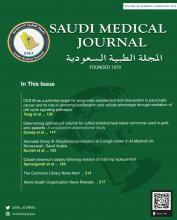To the Editor
We read with interest an article published in the journal titled “universal in-house neonatal hips ultrasonography screening in the United Arab Emirates”.1 The study aimed to investigate the incidence of developmental dysplasia of the hip (DDH) in a homogeneous cohort of neonates born in the Mediclinic Al Jowhara Hospital, Al Ain, United Arab Emirates (UAE). The researchers carried out universal ultrasonography hip screening using the Graf method on neonates in the maternity ward. The study included 2 groups for comparison: the Gulf Cooperation Council (GCC) group and the non-GCC group. The results show an overall DDH incidence of 1.7%, with a higher prevalence among neonates from the GCC region (2.9%) and significantly higher among girls from this region (6.3%). The incidence of immature hips (type IIa) was 9%, with similar rates regardless of geographical origin or gender. The findings suggest a need for a national ultrasonography DDH screening program, particularly for neonates from the GCC region, emphasizing the higher incidence among girls.
We congratulate the author for contributing to the understanding of DDH and highlighting the importance of considering regional and gender-specific factors in healthcare planning. The article’s meticulous investigation into geographical variations, clinical aspects, and the presence of risk factors in a homogeneous cohort of neonates has yielded valuable insights for the field.
There are several important factors that could guide future articles and improve their generalizability and social utility. First, the research was carried out as a single-center study; therefore, the small sample size could limit the statistical power of the study and impact the precision of the findings, although the article has acknowledged this limitation in the limitation section. Second, the accuracy of the Graf method has its own limitations, such as the expertise of the operator, infant positioning, the inability to capture hip dynamics, and the potential to miss mild dysplasia of the hip.2,3 Third, the retrospective nature of the data; and fourth, the lack of follow-up.
Not all children diagnosed as susceptible to DDH at birth will necessarily develop DDH in the future.4 It is crucial to carry out follow-up assessments with these susceptible children, as this process can yield valuable information.5 By obtaining data on children who did eventually develop DDH, we can analyze demographic variables specific to this group. Once we identify the peculiar characteristics of children who did develop DDH, this information can serve as a guide for policymakers and the healthcare system. Understanding the unique characteristics associated with the development of DDH enables us to be better prepared to implement necessary remedies and interventions.6 This sequential approach, from follow-up assessments to demographic analysis and policy considerations, ensures a systematic and informed strategy for addressing DDH in susceptible children.
Reply from the Author
Thank you for taking the time to read and engage with my study dealing with universal ultrasonography screening of neonatal hips using a Graf method in the UAE, which was published in the Saudi Medical Journal. I appreciate your thoughtful comments and the opportunity to address your observations.
A limitation of the study was the small cohort of neonates in the single-centre study. It would be perfect if the same study design could be applied in several centres to arrive at more statistically supportive results. The design used in the study is readily reproducible with one requirement only -having well trained and certified examiners. Graf courses for babies’ hips should be organized in the GCC region, and I am willing to assist in organizing the courses to create a broad base of educated professionals. The Graf technique is highly reliable and reproducible technique when carried out by well-trained examiners.3,7-9 The results collected from the multiple centres would, for sure, help in tailoring a regional DDH ultrasonography screening program.
Current knowledge of the natural course of the underdevelopment of infants’ hips, based on the capability of ultrasonography to clearly delineate all structures from the day of birth and also lessons that were learned from the too aggressive treatment in 20th century, has made it possible for us to strongly say that the universal ultrasonography DDH screening is not harmful and should be strongly considered.10
Looking back from consequences such as late diagnosed DDH and linking it to sources such as underdeveloped and untreated infant hips in the first days of life could also be useful; however, prevention of these cases through screening is a far better approach. An additional benefit of the screening program would be that it creates opportunities to directly inform the caregivers regarding the harmful effect that swaddling the babies’ legs too tightly could have on the development of their hips. This is very important, as it is a tradition that is deeply rooted in the GCC region.
Your insights have contributed significantly to the ongoing dialogue in our field, and I value the opportunity to engage in constructive discourse with you. If you have any further questions or comments, please feel free to reach out. Thank you again for your interest in my work.
- Copyright: © Saudi Medical Journal
This is an Open Access journal and articles published are distributed under the terms of the Creative Commons Attribution-NonCommercial License (CC BY-NC). Readers may copy, distribute, and display the work for non-commercial purposes with the proper citation of the original work.






